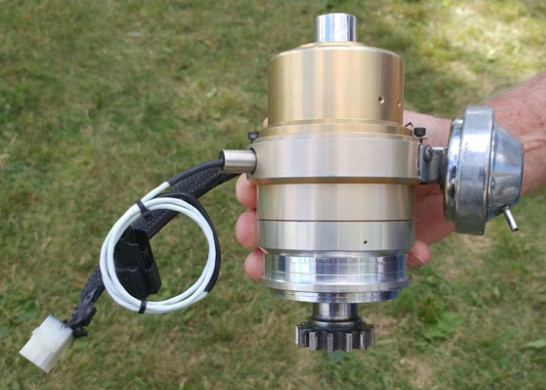Peter wrote:
the first?
I guess so. I remember that when the PA46 was new, there was much talk in the press about running its engine LOP. It was considered very exotic. Even more so in the prevailing culture at the time that leaning was dangerous. In my club, you were not permitted to lean the engine unless you had an IR. The rationale for that restriction was that IR pilots are better at following procedures and thus less likely to forget about the mixture control when descending or changing power setting.
From here
That looks glorious. Could one not leave the mag to the generating function only and replace the timing and distribution part of it (arguably the most fragile) with a Hall sensor on the flywheel driving a coil-on-plug arrangement? The way I see it there’d be more – not less- redundancy and reliability.
In the 1970s I used to build electronic ignitions for Yamahas (RD400 etc  ) and used a pickoff coil instead of the contacts.
) and used a pickoff coil instead of the contacts.
Perversely, it was found that the contacts lasted almost for ever when they carried little current…
I agree that they should have simply built a totally brushless (permanent magnet armature) alternator which powers a normal electronic ignition circuit… but these engines (well, their predecessors; the IO540-C4D5D is from the 1970s) date to before power transistors were commonly available, so a capacitor-discharge ignition was hard to make, and magnetos were the obvious way to do it. The earliest a CD ignition could have been built was the mid 1960s. So I guess the industry just got into a rut…
Peter wrote:
I agree that they should have simply built a totally brushless (permanent magnet armature) alternator which powers a normal electronic ignition circuit
These things exist. You probably know, but anyway:

Experimental of course, and not without it’s own problems. Kind of strange that no one has made a certified drop in replacement based on up to date technology.
I want that. Apparently they work on a certified 6 cylinder version. Ha.
I asked Electroair about turbo charged Lycomings and dual mags:
We are looking toward the end of fall for the turbo-charged 6cyl Lycoming engines to be completed. However, that expansion will not include the Lycoming engines that use the 6cyl Bendix Dual Magneto. Our timeline for a replacement to the Bendix 6cyl Dual Magneto is a couple of years away at this point. As for EASA, we are currently pursuing EASA STCs – our first one should be done by the end of this year.
This article says that the FAA won’t certify electronic ignition for both halves of the system. That is why current products replace only one of the two mags.
This is a new approach – a hybrid magneto

Basically it is a magneto but with the contacts implemented electronically.
Peter wrote:
he FAA won’t certify electronic ignition for both halves of the system
They effectively do just that with the Diesel engines and also many Turbofan types, e.g. Williams FJ44 with dual fadec
The e-mag and p-mag has been around for ages. They are electronic “mags”, drop in replacements, stand alone units (the e-mag). I don’t see what advantages this has on a certified engine. The advantage is the ability of variable timing for different RPMs and loads. With a certified engine, you cannot simply advance the ignition outside the specs (25 degrees or whatever). Possibly higher reliability would be the only advantage. For non certified engines it is normal to have one magneto and one e-mag. The e-mag will advance the ignition, giving better performance (in theory) while the magneto will function as normal, and as a backup.
LeSving wrote:
With a certified engine, you cannot simply advance the ignition outside the specs (25 degrees or whatever)
Says who? As it happens the Electroaire ignition does just that on certified engines.